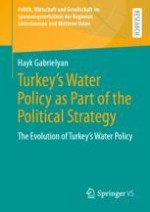This book investigates water issues in the Euphrates-Tigris basin between Turkey, Syria and Iraq (Iran). It presents the importance of water in the world and especially for the countries of the Euphrates-Tigris basin, the water resources of the three riparian countries, their advantages and disadvantages, the amount of reservoir construction in the three riparian countries, their water disagreements and conflicts, international water law. The importance of water in the Ottoman period is presented, the evolution of Turkey's water policy in the 20th and 21st centuries, the connection and interdependence of Turkey's water policy with its foreign and domestic policies are shown in detail. Separate reference is made to non-state actors, such as the Kurds of Turkey, Syria and Iraq. The work emphasizes that Turkey is a unique country in the world with its water policy in the Euphrates-Tigris basin: no other country is able to use water in such a multi-purpose way to achieve various goals.
